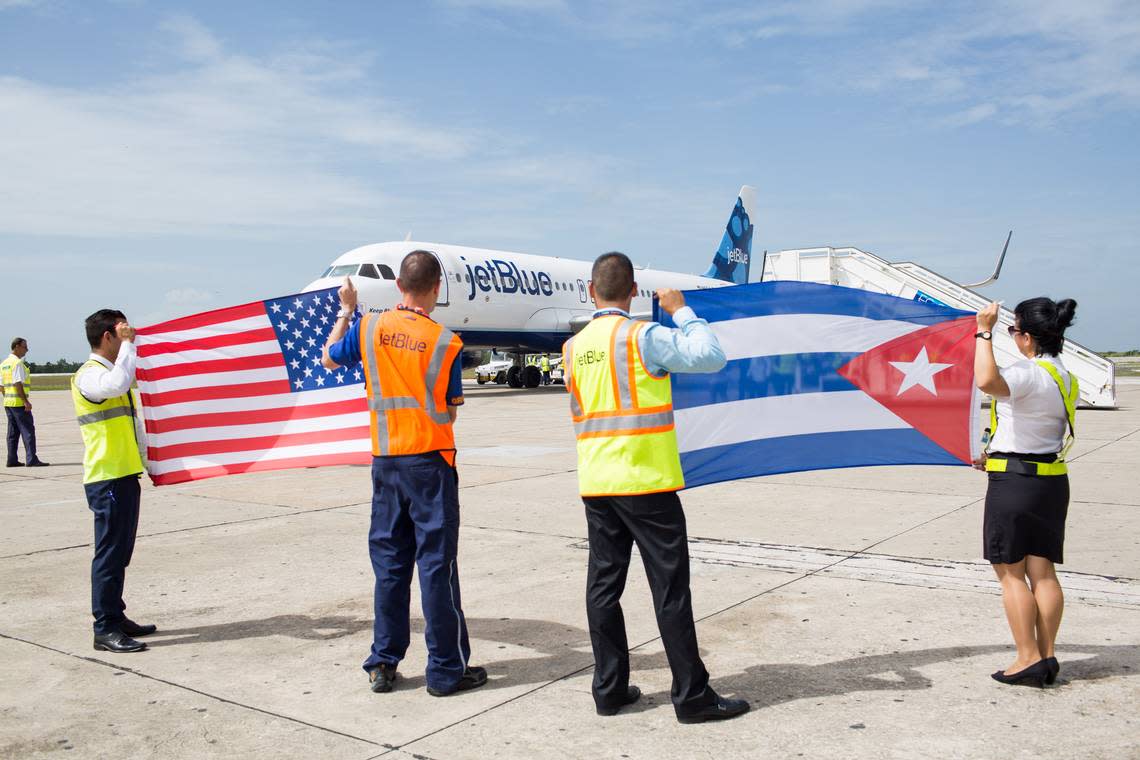These U.S. airlines are cutting flights to Cuba. Here’s why

JetBlue, the first U.S. commercial airline to resume flights to Cuba in more than 50 years in 2016, says it will suspend operations on the island due to low demand.
JetBlue said its final day of service will be Sept. 17 and that it will refund the money to those with flights booked for later this year. The company operated two daily flights to Havana from Fort Lauderdale and one Saturday flight from New York to the Cuban capital.
Delta and United Airlines plan to cut back on flights to the Caribbean island. Delta asked the U.S. Department of Transportation for a temporary suspension of all of its seven flights connecting Atlanta and Havana and seven of its 14 Miami-Havana flights between Oct. 29 and March 30 next year. Earlier in June, United notified the department that it would suspend its Newark-Havana services as of Oct. 29. American Airlines, which also flies to several cities in Cuba, has not announced any cutbacks in service.
“Demand for travel to the island has been significantly affected by changes to the regulatory landscape and restrictions on our customers’ ability to enter Cuba,” JetBlue said in a statement. “We look forward to resuming our service to Havana and continuing to pursue opportunities within Cuba should travel become more accessible in the future.”
The company did not reply to an email requesting clarification on the restrictions travelers face to enter Cuba. Both the U.S. and the Cuban government impose limits on who can travel to the island.
JetBlue was the first U.S. commercial airline to operate a flight to the island after diplomatic relations were restored under the Barack Obama administration, with an inaugural flight to Santa Clara in August 2016. But travel to Cuba took a hit from restrictions imposed by the Trump administration and the COVID-10 pandemic.
Trump banned flights to cities other than Havana, a measure reversed by the Biden administration last year. Anticipating higher demand, Jet Blue and other airlines asked the Department of Transportation to approve more flights to Cuba to increase connectivity between the two countries.
Americans cannot visit Cuba as tourists because of the U.S. trade embargo, but they can travel to the island under several authorized categories, including group trips for educational purposes. But despite expectations that Biden would go further, he did not lift restrictions banning Americans from going on their own to Cuba under a controversial category to promote individual contacts with the Cuban people, which critics say amounts to allowing tourism.
The Biden administration also left in place a ban on American travelers staying in hotels owned by the Cuban government.
On the Cuban side, the government has not allowed activists and critics to enter the country, putting U.S. airlines in a tough spot.
Cuban authorities themselves have released figures showing the decline in the number of Americans traveling to Cuba in recent years, from a peak of 638,365 in 2018 to just 99,012 from January to July of this year, according to Cuba’s National Statistics Office.
The number of Cubans abroad, including Cuban Americans, expected to travel to the island this year is also not likely to reach the 2018 peak, when 637,907 visited the country. Only 210,000 have visited Cuba this year as of July.
Many Cubans living in the United States have recently reunited with close relatives from the island, as more than 300,000 Cubans came to the country last year through the U.S.-Mexico border or on rafts. This may have reduced the need for Cuban Americans to travel to the island, experts say, though travel to visit family members in Cuba will likely remain strong.
“It is possible that the current economic conditions of the island and the United States, as well as the increase in Cuban emigration in the last two years, are reducing the trips of Cuban Americans to the island, but it is difficult to verify the impact of these factors in the current and future flow of visitors from the United States to Cuba,” said Jorge Duany, a migration expert and director of the Cuban Research Institute at Florida International University.
Commercial airlines also face competition from charter flights to Cuba, which are usually more expensive but provide Cubans and Cuban Americans flying from Miami and other cities the chance to take more luggage to the island, which many filled with much-needed food, medicines and other supplies for their relatives.
The country’s severe economic crisis, causing widespread shortages of food, bottled water, medicines and fuel, all essential to tourists, has also affected the number of people visiting the island.
“What does not appear to be on the way to a full recovery is the island’s battered tourism industry, which has seen visitor numbers well below pre-pandemic levels,” Duany said. “Compared to other Caribbean markets such as the Dominican or Puerto Rican markets, Cuban tourism has not yet recovered from the drop after the peak historical figures in 2018.”

